A Framework to Classify Environmental Inequity in Absolute and Relative Terms, and Its Application in Beijing
Abstract
:1. Introduction
2. Literature Review: Concepts about Environmental Inequity
3. The Framework of Inequity Classification
4. Application of the Framework in Beijing
4.1. Descriptive Analysis of Applied City Beijing
4.2. Implementing the Framework in Beijing
4.2.1. Step A: Select Variables and Compute Quotients
4.2.2. Step B: Transform Input Variables into Normalized Indicators with Compatible Units
4.2.3. Step C: Rank and Classify the Compatible Units in the Applied Area
4.2.4. Step D: Summarize the Inequity Classification in Absolute and Relative Terms
5. Discussion
5.1. Interpretation of the Environmental Inequity Results in Beijing
5.2. Notes on Potential Using the Framework
5.3. Limitations of the Framework
6. Conclusions
Supplementary Materials
Author Contributions
Funding
Conflicts of Interest
Nomenclature
| SDGs | sustainable development goals |
| PM2.5 | fine particular matter with aerodynamic diameter ≤2.5 µm |
| OK | Ordinary Kriging (interpolation model) |
| IDW | Inverse Distance Weighted (interpolation model) |
References
- Oestreich, J.E. SDG 10: Reduce inequality in and among countries. Soc. Altern. 2018, 37, 341–344. [Google Scholar]
- Landrigan, P.J.; Rauh, V.A.; Galvez, M.P. Environmental justice and the health of children. Mt. Sinai J. Med. 2010, 178–187. [Google Scholar] [CrossRef] [PubMed]
- Schweitzer, L.; Zhou, J. Neighborhood air quality, respiratory health, and vulnerable populations in compact and sprawled regions. J. Am. Plan. Assoc. 2010, 363–371. [Google Scholar] [CrossRef]
- Ji, S.; Cherry, C.R.; Zhou, W.; Sawhney, R.; Wu, Y.; Cai, S.; Wang, S.; Marshall, J.D. Environmental justice aspects of exposure to PM2.5 emissions from electric vehicle use in China. Env. Sci. Technol. 2015, 49, 13912–13920. [Google Scholar] [CrossRef] [PubMed]
- Padilla, C.M.; Deguen, S.; Lalloue, B.; Blanchard, O.; Beaugard, C.; Troude, F.; Navier, D.Z.; Vieira, V.M. Cluster analysis of social and environment inequalities of infant mortality. A spatial study in small areas revealed by local disease mapping in France. Sci. Total Env. 2013, 433–441, 454–455. [Google Scholar] [CrossRef] [PubMed] [Green Version]
- Ouyang, W.; Gao, B.; Cheng, H.; Hao, Z.; Wu, N. Exposure inequality assessment for PM2.5 and the potential association with environmental health in Beijing. Sci. Total Env. 2018, 635, 769–778. [Google Scholar] [CrossRef] [PubMed]
- Fecht, D.; Fischer, P.; Fortunato, L.; Hoek, G.; de Hoogh, K.; Marra, M.; Kruize, H.; Vienneau, D.; Beelen, R.; Hansell, A. Associations between air pollution and socioeconomic characteristics, ethnicity and age profile of neighborhoods in England and the Netherlands. Env. Pollut. 2015, 198, 201–210. [Google Scholar] [CrossRef] [PubMed]
- Fernández, I.C.; Wu, J. A GIS-based framework to identify priority areas for urban environmental inequity mitigation and its application in Santiago de Chile. Appl. Geogr. 2018, 94, 213–222. [Google Scholar] [CrossRef]
- Jenerette, G.D.; Harlan, S.L.; Buyantuev, A.; Stefanov, W.L.; Declet-Barreto, J.; Ruddell, B.L.; Myint, S.W.; Kaplan, S.; Li, X. Micro-scale urban surface temperatures are related to land-cover features and residential heat related health impacts in Phoenix, AZ USA. Landsc. Ecol. 2016, 31, 745–760. [Google Scholar] [CrossRef]
- Tessum, C.V.; Apte, J.S.; Goodkind, A.L.; Muller, N.Z.; Mullins, K.A.; Paolella, D.A.; Polasky, S.; Springer, N.P.; Thakrar, S.K.; Marshall, J.D.; et al. Inequity in consumption of goods and services adds to racial–ethnic disparities in air pollution exposure. PNAS 2019, 116, 6001–6006. [Google Scholar] [CrossRef] [PubMed] [Green Version]
- Kawachi, I.; Subramanian, S.V.; Almeida-Filho, N. A glossary for health inequalities. J. Epidemiol. Commun. Health 2002, 56, 647–652. [Google Scholar] [CrossRef] [PubMed]
- Pope, R.; Wu, J.; Boone, C. Spatial patterns of air pollutants and social groups: A distributive environmental justice study in the phoenix metropolitan region of USA. Env. Manag. 2016, 58, 753–766. [Google Scholar] [CrossRef] [PubMed]
- Jiang, L.; Bai, L. Spatio-temporal characteristics of urban air pollutions and their causal relationships: Evidence from Beijing and its neighboring cities. Sci. Rep. 2018, 8. [Google Scholar] [CrossRef] [PubMed] [Green Version]
- Van Kamp, I.; Leidelmeijera, K.; Marsmana, G.; de Hollander, A. Urban environmental quality and human well-being: Towards a conceptual framework and demarcation of concepts; a literature study. Landsc. Urban Plan. 2003, 65, 5–18. [Google Scholar] [CrossRef]
- Alicandro, G.; Sebasiani, G.; Bertuccio, B.; Zengarini, N.; Costa, G.; la Vecchia, C.; Frova, L. The main causes of death contributing to absolute and relative socio-economic inequality in Italy. Public Health 2018, 164, 39–48. [Google Scholar] [CrossRef] [PubMed]
- Chu, Y.; Liu, Y.; Lu, Y.; Yu, L. Propensity to migrate and willingness to pay related to Air pollution among different populations in Wuhan, China. Aerosol Air Qual. Res. 2017, 17, 752–760. [Google Scholar] [CrossRef] [Green Version]
- Chen, S.; Jin, H. Pricing for the clean air: Evidence from Chinese housing market. J. Clean. Prod. 2019, 206, 297–306. [Google Scholar] [CrossRef]
- Chatwin-Davies, R. Clearing the Air: The Impacts of Ambient Air Pollution on Environmental. Master’s Thesis, Carleton University, Ottawa, ON, Canada, 2018. [Google Scholar]
- Su, J.G.; Morello-Frosch, R.; Jesdale, B.M.; Kyle, A.D.; Shamasunder, B.; Jerrett, M. An index for assessing demographic inequalities in cumulative environmental hazards with application to los angeles, california. Env. Sci. Technol. 2009, 43, 7626–7634. [Google Scholar] [CrossRef] [PubMed] [Green Version]
- Liu, J.; Li, W.; Wu, J. A framework for delineating the regional boundaries of PM2 5 pollution: A case study of China. Env. Pollut. 2018, 235, 642–651. [Google Scholar] [CrossRef] [PubMed]
- De Toro, P.; Nocca, F.; Renna, A.; Sepe, L. Real estate market dynamics in the city of naples: An integration of a multi-criteria decision analysis and geographical information system. Sustainability 2020, 12, 1211. [Google Scholar] [CrossRef] [Green Version]
- Zhao, H.; Geng, G.; Zhang, Q.; Davis, S.J.; Li, X.; Liu, Y.; Peng, L.; Li, M.; Zheng, B.; Huo, H. Inequality of household consumption and air pollution-related deaths in China. Nat. Commun. 2019, 10, 43367. [Google Scholar] [CrossRef] [PubMed] [Green Version]
- Liang, H.; Dong, L.; Luo, X.; Ren, J.; Zhang, N.; Gao, Z.; Dou, Y. Balancing regional industrial development: Analysis on regional disparity of China’s industrial emissions and policy implications. J. Clean Prod. 2016, 126, 223–235. [Google Scholar] [CrossRef]
- Zheng, S.; Fu, Y.; Liu, H. Housing-choice hindrances and urban spatial structure: Evidence from matched location and location-preference data in Chinese cities. J. Urban Econ. 2006, 60, 535–557. [Google Scholar] [CrossRef]
- Zheng, S.; Kahn, M.E. Land and residential property markets in a booming economy: New evidence from Beijing. J. Urban Econ. 2008, 63, 743–757. [Google Scholar] [CrossRef]
- Gautam, S.; Patra, A.K.; Kumar, P. Status and chemical characteristics of ambient PM2.5 pollutions in China: A. review. Env. Dev. Sustain. 2019, 21, 1649–1674. [Google Scholar] [CrossRef]
- Gautam, S.; Yadav, A.; Tsai, C.J.; Kumar, P.A. A review on recent progress in observations, sources, classification and regulations of PM2.5 in Asian environments. Env. Sci. Pollut. Res. 2016, 23, 21165–21175. [Google Scholar] [CrossRef] [PubMed]
- Hao, Y.; Liu, Y. The influential factors of urban PM2.5 concentrations in China: A spatial econometric analysis. J. Clean. Prod. 2016, 112, 1443–1453. [Google Scholar] [CrossRef]
- Cutter, S.L.; Boruff, B.J.; Shirley, W.L. Social Vulnerability to Environmental. Soc. Sci. Q. 2003, 2. [Google Scholar] [CrossRef]
- Boulanger, G.; Bayeux, T.; Mandin, C.; Kirchner, S.; Vergriette, B.; Pernelet-Joly, V.; Kopp, P. Socio-economic costs of indoor air pollution: A tentative estimation for some pollutants of health interest in France. Environ. Int. 2017, 104, 14–24. [Google Scholar] [CrossRef] [PubMed]
- Liu, M.; Huang, Y.; Jin, Z.; Ma, Z.; Liu, X.; Zhang, B.; Liu, Y.; Yu, Y.; Wang, J.; Bi, J. The nexus between urbanization and PM2.5 related mortality in China. Environ. Pollut. 2017, 227, 15–23. [Google Scholar] [CrossRef]
- Zanobetti, A.; Schwartz, J. The effect of fine and coarse particulate air pollution on mortality: A national analysis. Environ. Health Perspect. 2009, 117, 898–903. [Google Scholar] [CrossRef] [PubMed] [Green Version]
- Honda, T.; Pun, V.C.; Manjourides, J.; Suh, H. Anemia prevalence and hemoglobin levels are associated with long-term exposure to air pollution in an older population. Environ. Int. 2017, 101, 125–132. [Google Scholar] [CrossRef] [PubMed]
- Kan, H.; London, S.J.; Chen, G.; Zhang, Y.; Song, G.; Zhao, N.; Jiang, L.; Chen, B. Season, sex, age, and education as modifiers of the effects of outdoor air pollution on daily mortality in Shanghai, China: The public health and air pollution in Asia (PAPA) study. Environ. Health Perspect. 2008, 116, 1183–1188. [Google Scholar] [CrossRef] [PubMed]
- Rosofsky, A.; Levy, J.I.; Zanobetti, A.; Janulewicz, P.; Fabian, M.P. Temporal trends in air pollution exposure inequality in Massachusetts. Environ. Res. 2018, 161, 76–86. [Google Scholar] [CrossRef] [PubMed]
- Li, V.O.; Han, Y.; Lam, J.C.; Zhu, Y.; Bacon-Shone, J. Air pollution and environmental injustice: Are the socially deprived exposed to more PM2.5 pollution in Hong Kong? Environ. Sci. Policy 2018, 80, 53–61. [Google Scholar] [CrossRef]
- Xu, Y.; Jiang, S.; Li, R.; Zhang, J.; Zhao, J.; Abbar, S.; Gonzales, M.C. Unraveling environmental justice in ambient PM2.5 exposure in Beijing: A big data approach. Comput. Environ. Urban Syst. 2019, 75, 12–21. [Google Scholar] [CrossRef]
- Zhang, Y.; Lang, J.; Cheng, S.; Li, S.; Zhou, Y.; Chen, D.; Zhang, H.; Wang, H. Chemical composition and sources of PM1 and PM2.5 in Beijing in autumn. Sci. Total Environ. 2018, 630, 72–82. [Google Scholar] [CrossRef] [PubMed]
- Wu, J.; Li, J.; Peng, J.; Li, W.; Xu, G.; Dong, C. Applying land use regression model to estimate spatial variation of PM2.5 in Beijing, China. Environ. Sci. Pollut. Res. 2015, 22, 7045–7061. [Google Scholar] [CrossRef] [PubMed]
- Kong, L.; Xin, J.; Liu, Z.; Zhang, K.; Tang, G.; Zhang, W.; Wang, Y. The PM2.5 threshold for aerosol extinction in the Beijing megacity. Atmos. Environ. 2017, 167, 458–465. [Google Scholar] [CrossRef]
- Yin, H.; Pizzol, M.; Xu, L. External costs of PM2.5 pollution in Beijing, China: Uncertainty analysis of multiple health impacts and costs. Environ. Pollut. 2017, 226, 356–369. [Google Scholar] [CrossRef]
- Bayraktar, H.; Turalioglu, F.S. A kriging-based approach for locating a sampling site—In the assessment of air quality. Stoch. Environ. Res. Risk Assess. 2005, 19, 301–305. [Google Scholar] [CrossRef]
- Wu, J.; Gyourko, J.; Deng, Y. Evaluating the risk of Chinese housing markets: What we know and what we need to know. China Econ. Rev. 2016, 39, 91–114. [Google Scholar] [CrossRef] [Green Version]
- Wu, J.; Gyourko, J.; Deng, Y. Evaluating conditions in major Chinese housing markets. Reg. Sci. Urban Econ. 2012, 42, 531–543. [Google Scholar] [CrossRef] [Green Version]
- Villar, J.G.; Raya, J.M. Use of a Gini index to examine housing price heterogeneity: A quantile approach. J. Hous. Econ. 2015, 29, 59–71. [Google Scholar] [CrossRef]
- Wu, Y.; Chen, C.; Du, Y.; Chen, Z.; Li, Y. Investigation of Indoor and Outdoor PM2.5 Pollution Situation in Beijing. Procedia Eng. 2017, 205, 1223–1229. [Google Scholar] [CrossRef]
- Bell, M.L.; Ebisu, K. Environmental inequality in exposures to airborne particulate matter components in the United States. Environ. Health Perspect. 2012, 120, 1699–1704. [Google Scholar] [CrossRef] [PubMed]
- Carrier, M.; Apparicio, P.; Séguin, A. Road traffic noise in Montreal and environmental equity: What is the situation for the most vulnerable population groups? J. Transp. Geogr. 2016, 51, 1–8. [Google Scholar] [CrossRef]
- Shen, Y.; Sun, F.; Che, Y. Public green spaces and human wellbeing: Mapping the spatial inequity and mismatching status of public green space in the central city of Shanghai. Urban For. Urban Green. 2017, 27, 59–68. [Google Scholar] [CrossRef]
- Azócar, G.; Romero, H.; Sanhueza, R.; Vega, C.; Aguayo, M.; Munoz, M.D. Urbanization patterns and their impacts on social restructuring of urban space in Chilean mid-cities: The case of Los Angeles, Central Chile. Land Use Policy 2007, 24, 199–211. [Google Scholar] [CrossRef]
- Barceló, M.A.; Saez, M.; Saurina, C. Spatial variability in mortality inequalities, socioeconomic deprivation, and air pollution in small areas of the Barcelona Metropolitan Region, Spain. Sci. Total Environ. 2009, 407, 5501–5523. [Google Scholar] [CrossRef] [PubMed]
- Fan, X.; Lam, K.; Yu, Q. Differential exposure of the urban population to vehicular air pollution in Hong Kong. Sci. Total Environ. 2012, 426, 211–219. [Google Scholar] [CrossRef] [PubMed]
- Moreno-Jiménez, A.; Cañada-Torrecilla, R.; Vidal-Dominguez, M.J.; Palacios-Garcia, A.; Martinez-Suarez, P. Assessing environmental justice through potential exposure to air pollution: A socio-spatial analysis in Madrid and Barcelona, Spain. Geoforum 2016, 69, 117–131. [Google Scholar] [CrossRef]
- Storper, M. Governing the large metropolis. Territ. Politics Gov. 2014, 2, 115–134. [Google Scholar] [CrossRef]
- McCall, M.K.; Dunn, C.E. Geo-information tools for participatory spatial planning: Fulfilling the criteria for ‘good’ governance? Geoforum 2012, 43, 81–94. [Google Scholar] [CrossRef]
- Kropp, W.W.; Lein, J.K. Assessing the geographic expression of urban sustainability: A scenario based approach incorporating spatial multicriteria decision analysis. Sustainability 2012, 4, 2348–2365. [Google Scholar] [CrossRef] [Green Version]
- Vieira, B.O.; Guarnieri, P.; Camara e Silva, L.; Alfinito, S. Prioritizing barriers to be solved to the implementation of reverse logistics of e-waste in brazil under a multicriteria decision aid approach. Sustainability 2020, 12, 4337. [Google Scholar] [CrossRef]
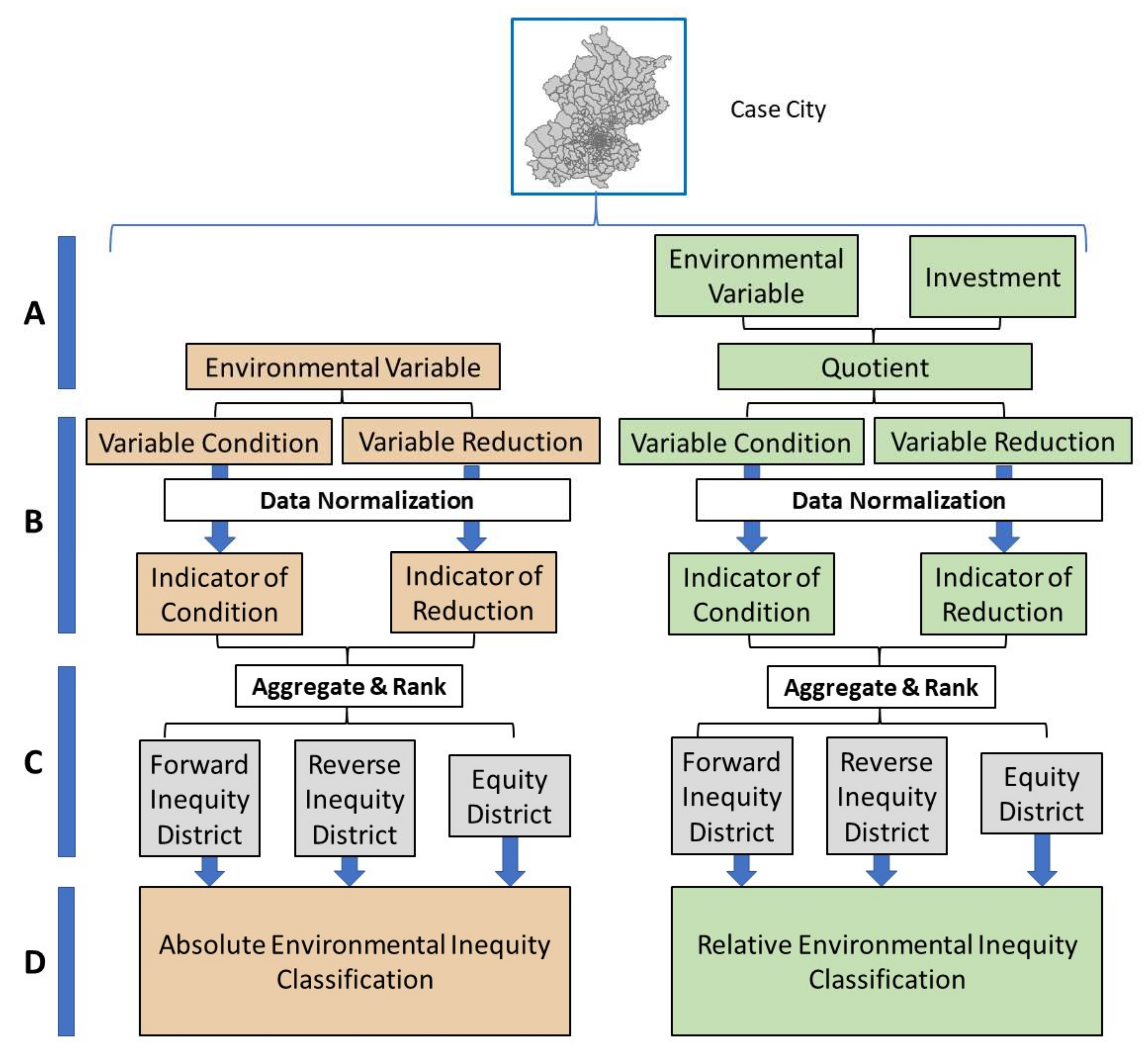
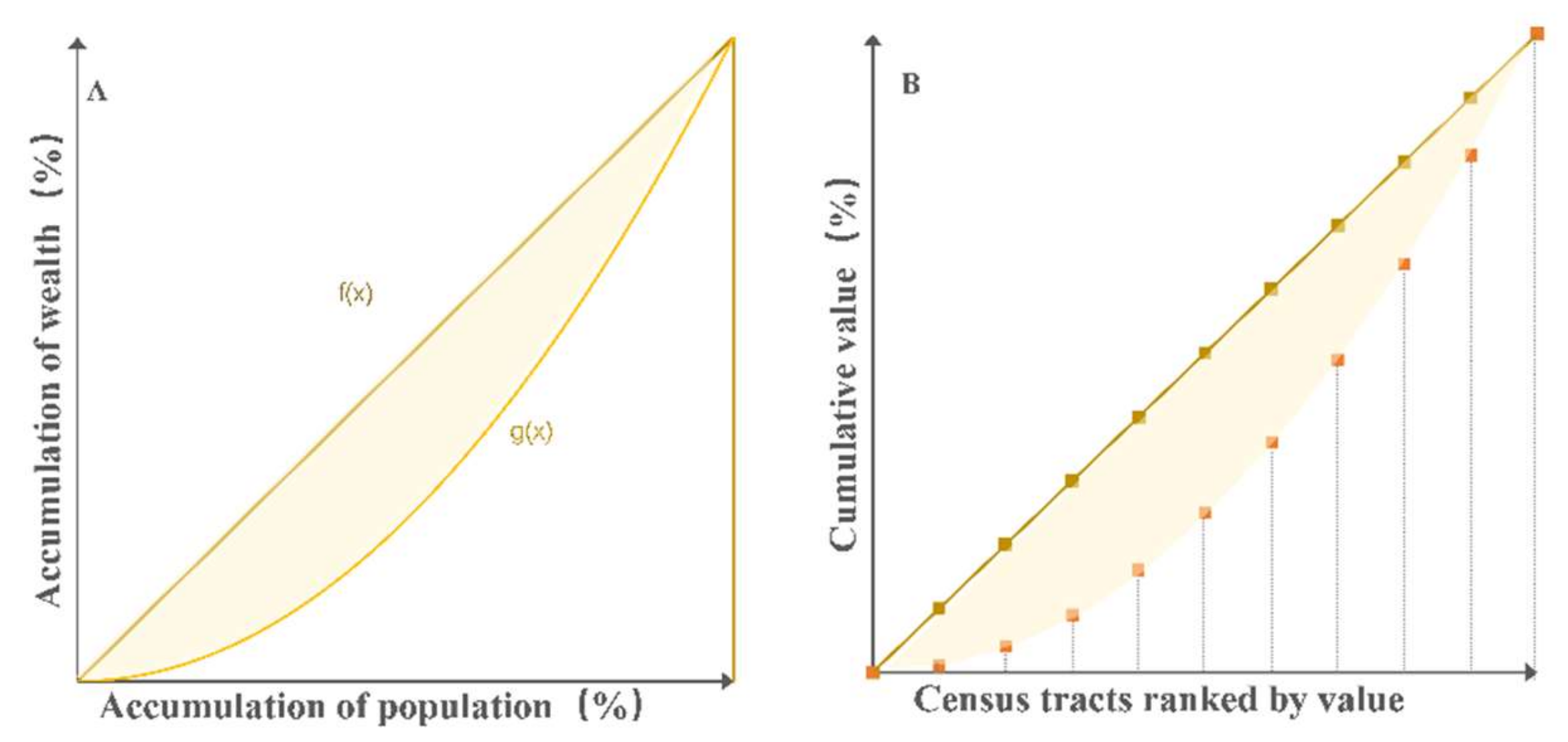
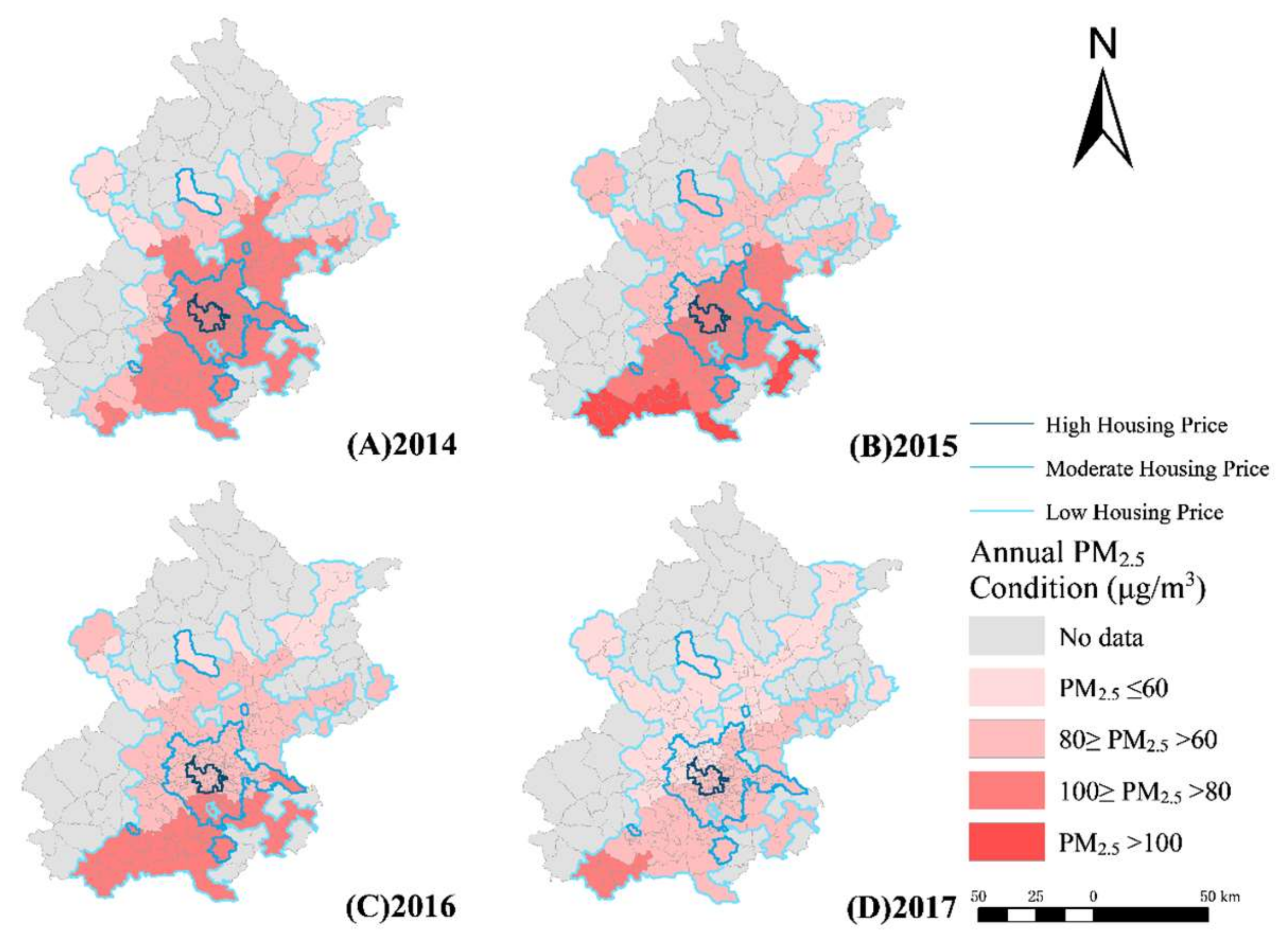
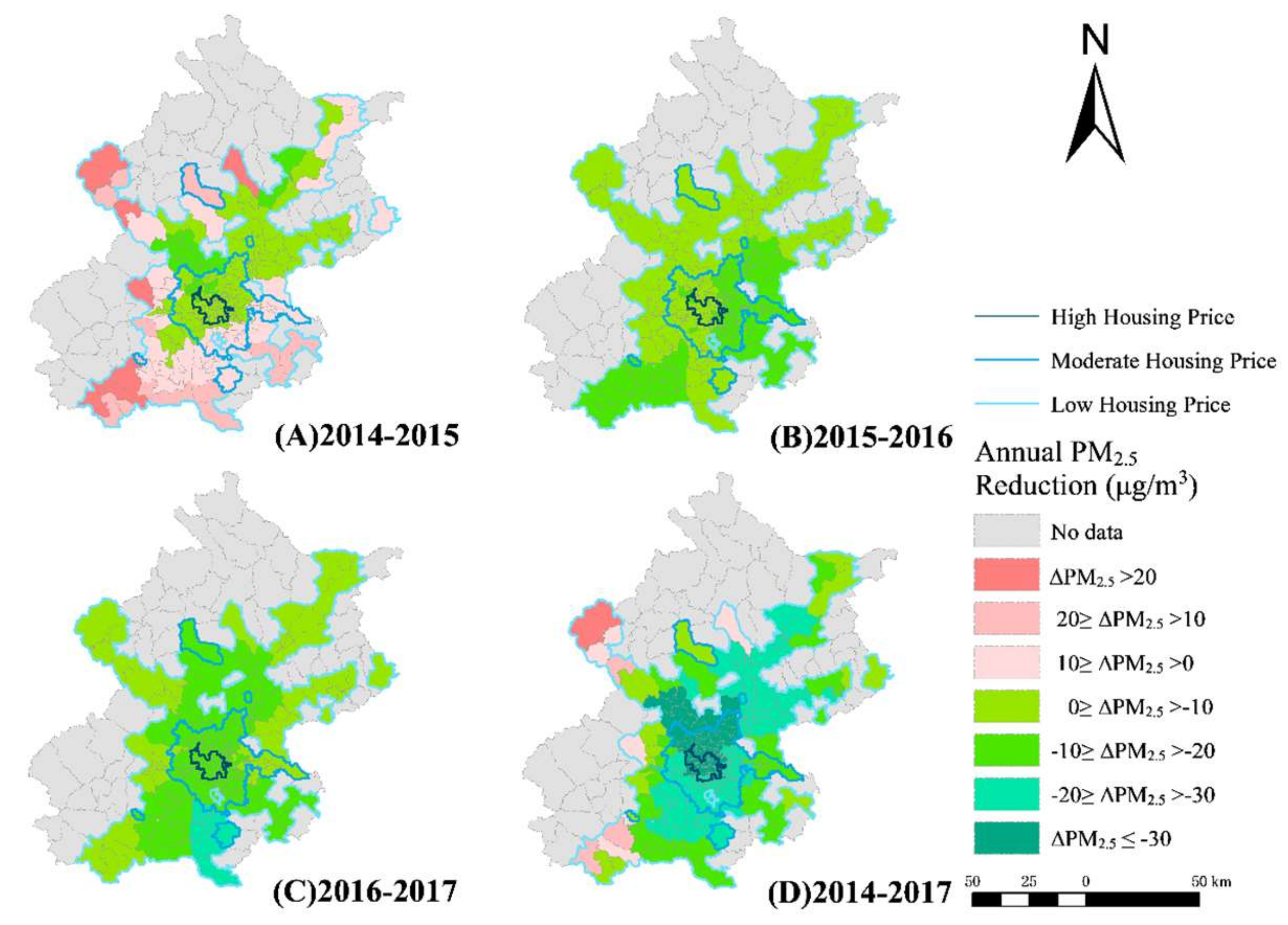
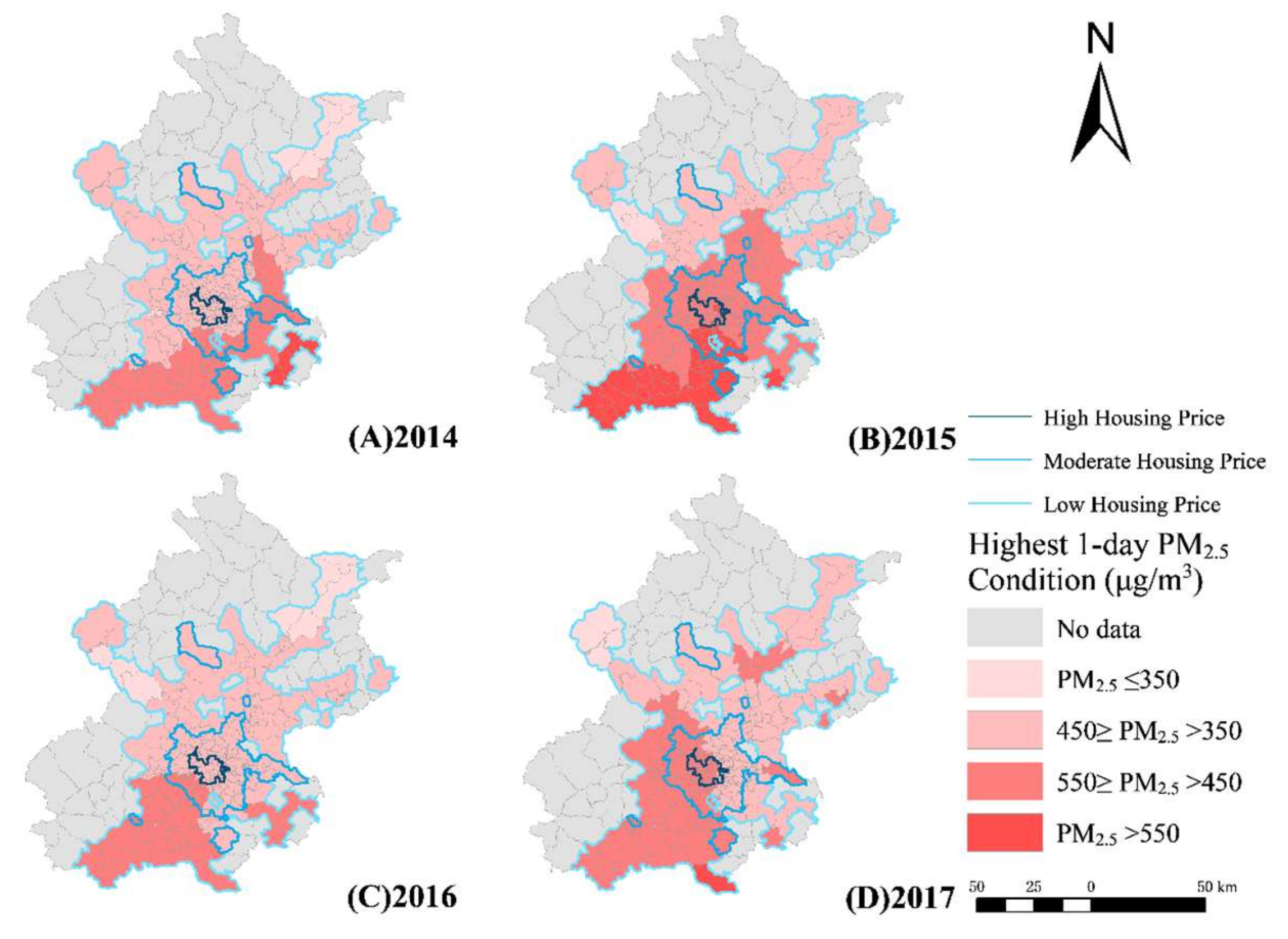

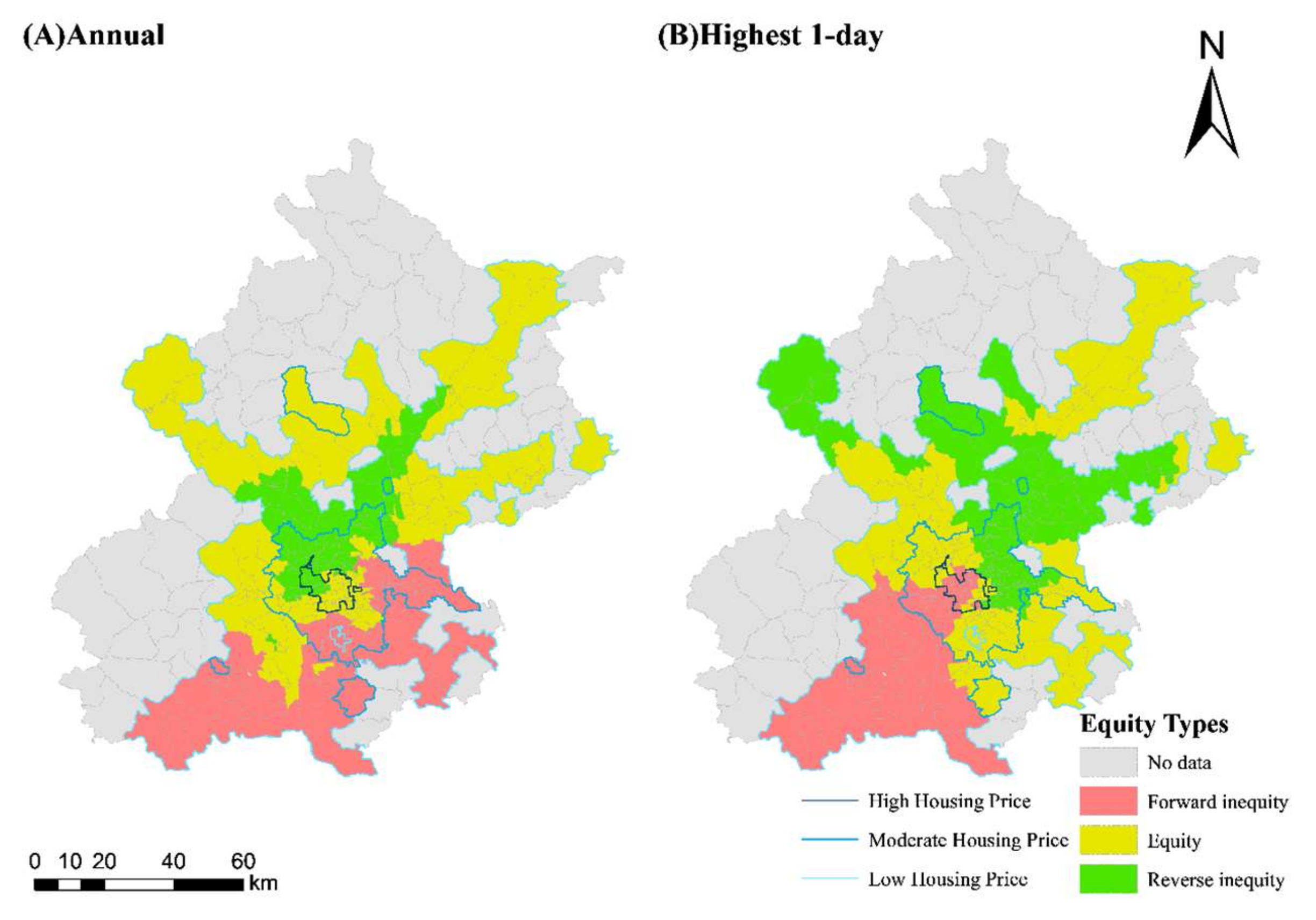

| By Pollution (Chronic) | By Pollution (Acute) | By quotient (Chronic) | By Quotient (Acute) | |
|---|---|---|---|---|
| 2014 | 0.090 | 0.176 | 0.788 | 0.479 |
| 2015 | 0.193 | 0.175 | 0.572 | 0.567 |
| 2016 | 0.200 | 0.192 | 0.557 | 0.468 |
| 2017 | 0.230 | 0.167 | 0.475 | 0.506 |
© 2020 by the authors. Licensee MDPI, Basel, Switzerland. This article is an open access article distributed under the terms and conditions of the Creative Commons Attribution (CC BY) license (http://creativecommons.org/licenses/by/4.0/).
Share and Cite
Wu, J.; Zhou, J.; Zhang, W. A Framework to Classify Environmental Inequity in Absolute and Relative Terms, and Its Application in Beijing. Sustainability 2020, 12, 4757. https://doi.org/10.3390/su12114757
Wu J, Zhou J, Zhang W. A Framework to Classify Environmental Inequity in Absolute and Relative Terms, and Its Application in Beijing. Sustainability. 2020; 12(11):4757. https://doi.org/10.3390/su12114757
Chicago/Turabian StyleWu, Jiansheng, Junhao Zhou, and Wen Zhang. 2020. "A Framework to Classify Environmental Inequity in Absolute and Relative Terms, and Its Application in Beijing" Sustainability 12, no. 11: 4757. https://doi.org/10.3390/su12114757




